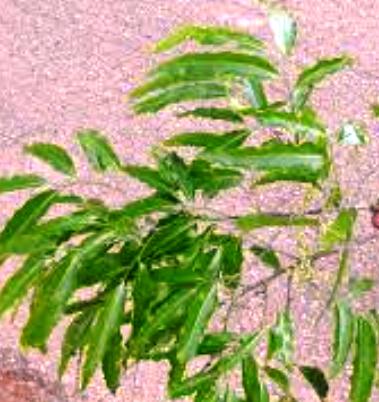Polyalthia suaveolens

|
|
Polyalthia suaveolens Common Names: Sweet-scented Polyalthia, African
Polyalthia Scientific
Classification Kingdom: Plantae Phylum: Angiosperms Class: Eudicots Order: Magnoliales Family: Annonaceae Genus: Polyalthia Species: P. suaveolens Binomial Name: Polyalthia suaveolens Engl. & Diels Synonyms: Greenwayodendron
suaveolens (Engl. &
Diels) Verdc., Polyalthia oliveri Engl. var. gabonica Pellegr. Morphological Description Polyalthia suaveolens is a medium-sized evergreen tree, typically growing to 10–25
m in height, with a straight trunk and dense canopy. It is characterized by: · Stem: Slender, cylindrical trunk (up to 50 cm in diameter), with
smooth, dark brown bark that exudes a resinous sap when cut · Leaves: Glossy, dark green, oblong to lanceolate (8–15 cm long, 3–6
cm wide), alternate, with a leathery texture · Flowers: Small, aromatic, yellowish-green to pale yellow (1–2 cm in
diameter), borne in axillary clusters, emitting a sweet fragrance · Fruit: Clusters of berries (1–2 cm in diameter), green turning
black when ripe, each containing 1–2 seeds The tree’s fragrant
flowers and glossy foliage make it a notable ornamental species in tropical landscapes
(Verdcourt, 1971). Distribution and Habitat Polyalthia suaveolens is native to tropical West and Central Africa, including
Nigeria, Ghana, Cameroon, and the Democratic Republic of Congo, with some
presence in Southeast Asia (e.g., Malaysia, Indonesia). It thrives in: · Lowland Rainforests: Humid, shaded understories with
temperatures of 25–35°C · Secondary Forests: Regenerating areas with fertile,
well-drained soils · Riverbanks: Moist, alluvial zones up to 1,200 m elevation It prefers loamy or
sandy soils (pH 5.5–7.0) and annual rainfall of 1,500–3,000 mm, often growing
alongside streams or in forest clearings (Le Thomas, 1969). Ethnopharmacology Polyalthia suaveolens, a tropical tree native to West and Central Africa, has been
traditionally utilized in African folk medicine for various ailments. In Gabon,
the bark is used to alleviate stomachaches, while in the Democratic Republic of
Congo, the roots are esteemed as an aphrodisiac and vermifuge. Phytochemical
studies have identified compounds such as polycarpol in the bark, which may
contribute to its medicinal properties. Pharmacological research indicates that
extracts from Polyalthia suaveolens exhibit significant antiplasmodial
activity, suggesting potential efficacy against malaria. Additionally, the
plant has demonstrated antitrypanosomal properties, indicating possible
benefits in treating trypanosome infections. While these findings underscore
the therapeutic potential of Polyalthia suaveolens, further research is
necessary to fully elucidate its medicinal properties and ensure its safety and
efficacy in clinical applications. · Antipyretic: In Ghana, bark decoctions treat fever. · Anti-inflammatory: In Nigeria, leaf pastes alleviate pain and
swelling. Methanol extracts inhibit paw edema by 45–60% in rats at 300 mg/kg,
due to quercetin and β-sitosterol (Checker et al., 2012). · Antimicrobial: In DR Congo, root extracts combat infections. Essential oils
inhibit Staphylococcus aureus (MIC 0.31 mg/mL) and Candida albicans (MIC 0.62 mg/mL), attributed to polycarpol
(Muganza et al., 2016). · Antimalarial: In Cameroon, stem bark treats malaria. Hydroalcoholic
extracts show antiplasmodial activity against Plasmodium falciparum K1 strain (IC₅₀ 5–10 µg/mL) (Gbedema et
al., 2015). · Analgesic: In Malaysia, leaf infusions relieve pain. Ethanol extracts
increase pain threshold by 30–40% in mice at 200 mg/kg (Sura et al., 2018). ⚠ Toxicity Profile: Generally safe in traditional doses (LD₅₀ >
2,000 mg/kg in rats), high doses (>1,000 mg/kg) of root extracts may cause
hepatotoxicity due to polycarpol and diterpenoids. The resinous sap can
irritate skin (PII 1.5–2.0). Caution is advised (Muganza et al., 2016). Phytochemistry The plant’s medicinal
properties are driven by its rich phytochemical profile: · Terpenoids: Polycarpol, dihydropolycarpol (0.1–0.3%), with antimicrobial
and antimalarial effects · Flavonoids: Quercetin, kaempferol (0.05–0.2%), contributing to
anti-inflammatory and antioxidant activity · Alkaloids: Indolosesquiterpenes (e.g., isopolyalthenol), linked to analgesic
properties · Essential Oils: β-caryophyllene, linalool, enhancing
fragrance and antimicrobial action These compounds,
identified via GC-MS and NMR, underscore its therapeutic potential (Muganza et
al., 2016). Additional Uses · Ecological: Provides nesting sites for birds and nectar for pollinators
like bees · Cultural: Flowers and bark used in Nigerian rituals for purification
and healing · Ornamental: Planted for its aesthetic appeal and shade in tropical
gardens References
External Links More Pictures |
|
| Compounds of Polyalthia suaveolens | |
| References | Murtala Muhammad, Etal. (2023). Phytochemical
analysis of Nigerian medicinal plants. NMPP-DB Project, Department
of Biochemistry, Kano University of Science and Technology, Wudil |